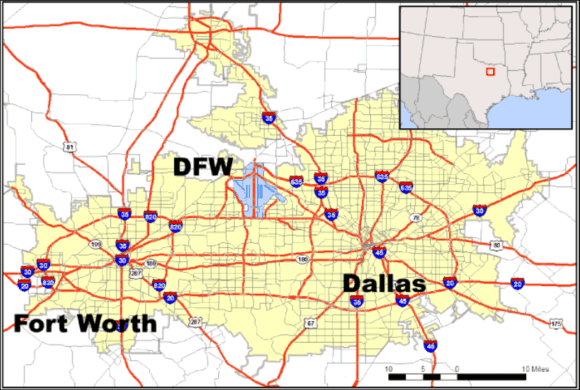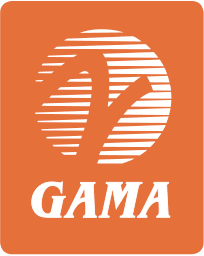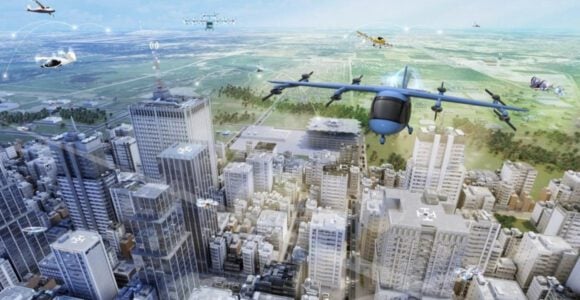Economic development is a highly competitive business. Communities pursue companies to locate in their areas because of the benefits they offer. As one of six guests of the Fort Worth EDP (Economic Development Partnership) over the past two days, your correspondent was exposed to this activity up close.
It helps to get a mental picture of the area under discussion. The tiny map shows the location of North Texas. The larger map displays what is inside the little red box. It is a sprawling metropolis, locally referred to as the “Metroplex.”

The Dallas–Fort Worth metroplex (officially the Dallas–Fort Worth–Arlington Metropolitan Statistical Area) had an estimated population of 8,344,032 residents as of July 1, 2024, according to the latest U.S. Census Bureau annual estimates released in May 2025. This represents a gain of 177,922 people (or 2.2%) from the previous year, making it the fastest-growing metro area in the U.S. by numeric growth.
Moreover, this metro area spans 13 counties in North Texas and is the fourth-largest in the U.S., behind New York, Los Angeles, and Chicago. Its rapid expansion is driven by job creation in tech, finance, and logistics, as well as domestic migration. We constantly heard about fast growth at every site visit.
Ft Worth
The focus in this post is on the left side of the map. The competition between the two cities is friendly, sort of. One quip we heard is that Ft Worth is two-thirds of DFW. Economic rivalry between the two is real. Whereas Dallas is more constrained geographically and has to grow vertically, Ft Worth has space. Even as they compete, a win for one creates a trickle-over win for the other.
Ft Worth was blessed with visionary boosters, starting with Amon Carter. Another famous name is Ross Perot, and his son, Ross Perot Jr., is following in his footsteps. Boosterism is a key requirement for economic development.
Ft Worth’s EDP is only two years old and has attracted 11,000 jobs and nearly $10 billion in capital investment. This is remarkable and reflects the region’s rapid growth. While this growth spans all industries, our focus is on the aviation sector, specifically commercial aviation.
Ft Worth is fortunate to be at a nexus of transportation links. Starting with the old cattle drives on the Chisholm Trail, to railroad links and freeways. Economic history teaches that a confluence of transportation links is the cornerstone of community development. Today, that cornerstone requires the golden thread of commercial aviation to connect the community to the global economy.
The Aviation Angle
Our friend Jon Ostrower is the source for an apropos statement: “There’s always an aviation angle.” And it holds here, too.
Ft Worth has two important aviation OEMs. Lockheed Martin and Bell Helicopter. The former has a mile-long factory dating from World War 2 that started as a B-24 plant producing 11 bombers per day. Today, it has 200 bays building F-35s—and despite thousands of workers and its huge workspace, it may be one of the quietest FALs your correspondent has visited. Both OEMs are focused on military production, so there were few data points and zero photography. However, military production means stable work for the region for many years.
The region also has a major commercial aviation hub at DFW airport, connecting it globally. Home to American Airlines, which operates a fleet of 1,000 commercial aircraft, DFW is a significant economic engine. To the south of Dallas, 20 miles away, is Love Field, home to Southwest Airlines and its 815 aircraft. The region is home to nearly one-third of the US airline fleet, and nobody else comes close.
But even DFW has its limits, and, as a long-term solution, Ft Worth booster Ross Perot created Alliance Airport. Its full name is Perot Field Fort Worth Alliance Airport (IATA: AFW, ICAO: KAFW), and is the world’s first purely industrial airport, designed from the ground up for cargo, logistics, manufacturing, and aviation support—not passenger service. The airport has twin 11,000-foot runways. Alliance Airport attracted important industry tenants. These tenants serve to boost the aerocluster.
DFW has four runways, each 13,400 feet long. DFW is the only airport worldwide with four serviceable paved runways exceeding 4,000 meters. Everything is bigger in Texas.
Alliance Airport has attracted important business. Amazon now has its regional operations at Alliance. Another interesting tenant is Aspire MRO. This company converts passenger aircraft to freighters. Just this week, a former Delta 777LR that most recently served Air India was retired and flown to Alliance for its next phase of service. Alliance’s reach is global—a Mongolian 767 recently flew 15 hours to Alliance for an engine change and, three days later, flew back to Mongolia.
Ft Worth Aerocluster
Alliance Airport is likely to become a cornerstone for the emerging Ft Worth aerocluster. The most recent news is Embraer’s decision to build MRO capacity at Alliance, adding to its existing capacity there. Another key tenant is MTU, and its facility is focused on servicing LEAP engines. Conveniently, American Airlines and Southwest are both major LEAP operators.
In addition to the Alliance site, American is adding a new $4 billion terminal at DFW, and Bell is investing $800 million in its MV-75 program. Alliance Airport is also supporting the emerging EVTOL industry in several innovative ways. The Perot family’s aviation interest permeates the airport’s thinking. But there’s more than aviation; the airport is also helping entrepreneurs develop self-driving trucks. The IP from this will inform its own infrastructure development. They cite lessons learned from early EVTOL program testing that informed decisions about power system development.
Outside the Ft Worth aerospace field, Siemens is investing $190 million in a new manufacturing plant, while Taiwan-based Wistron is investing $761 million to establish AI supercomputer facilities. Success breeds success.
Challenges
All the investments described are drawing in talent. And therein lies the first challenge. The aerospace industry faces a global talent shortage. Ft Worth would do well to learn from Embraer and its São José dos Campos facility. Embraer built its own schools to develop the talent it needed. Texas A&M is already playing a role in Ft Worth, but talent demand is rising fast. Lockheed Martin is actively engaged with local schools to build STEM talent.
The next challenge will be water. It is worth noting that Dallas, some 30 miles to the east, receives one inch more rain per year than Ft Worth. Ft Worth will need a lot of water to support its population growth over the following decades. And it’s more than water—electrical power is crucial.
Ft Worth’s boosters succeeded. The current visionaries and leaders need to ensure the inputs required to maintain that momentum are in place.
Views: 136




